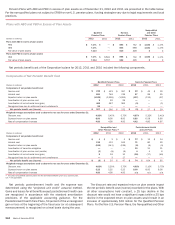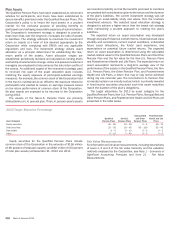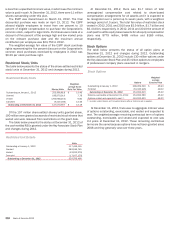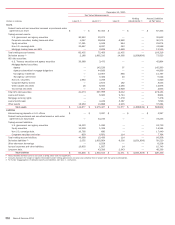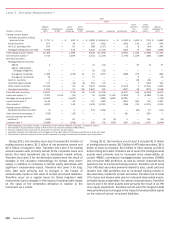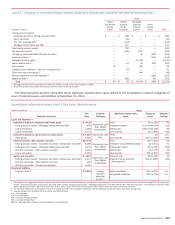Bank of America 2012 Annual Report Download - page 256
Download and view the complete annual report
Please find page 256 of the 2012 Bank of America annual report below. You can navigate through the pages in the report by either clicking on the pages listed below, or by using the keyword search tool below to find specific information within the annual report.254 Bank of America 2012
Derivative Assets and Liabilities
The fair values of derivative assets and liabilities traded in the
OTC market are determined using quantitative models that utilize
multiple market inputs including interest rates, prices and indices
to generate continuous yield or pricing curves and volatility factors
to value the position. The majority of market inputs are actively
quoted and can be validated through external sources, including
brokers, market transactions and third-party pricing services.
When third-party pricing services are used, the methods and
assumptions used are reviewed by the Corporation. Estimation
risk is greater for derivative asset and liability positions that are
either option-based or have longer maturity dates where
observable market inputs are less readily available, or are
unobservable, in which case, quantitative-based extrapolations of
rate, price or index scenarios are used in determining fair values.
The fair values of derivative assets and liabilities include
adjustments for market liquidity, counterparty credit quality and
other instrument-specific factors, where appropriate. In addition,
the Corporation incorporates within its fair value measurements
of OTC derivatives a valuation adjustment to reflect the credit risk
associated with the net position. Positions are netted by
counterparty, and fair value for net long exposures is adjusted for
counterparty credit risk while the fair value for net short exposures
is adjusted for the Corporation’s own credit risk. An estimate of
severity of loss is also used in the determination of fair value,
primarily based on market data.
Loans and Loan Commitments
The fair values of loans and loan commitments are based on
market prices, where available, or discounted cash flow analyses
using market-based credit spreads of comparable debt
instruments or credit derivatives of the specific borrower or
comparable borrowers. Results of discounted cash flow
calculations may be adjusted, as appropriate, to reflect other
market conditions or the perceived credit risk of the borrower.
Mortgage Servicing Rights
The fair values of MSRs are determined using models that rely on
estimates of prepayment rates, the resultant weighted-average
lives of the MSRs and the OAS levels. For more information on
MSRs, see Note 24 – Mortgage Servicing Rights.
Loans Held-for-sale
The fair values of LHFS are based on quoted market prices, where
available, or are determined by discounting estimated cash flows
using interest rates approximating the Corporation’s current
origination rates for similar loans adjusted to reflect the inherent
credit risk.
Other Assets
The fair values of certain debt securities and AFS marketable equity
securities are generally based on quoted market prices or market
prices for similar assets. However, non-public investments are
initially valued at the transaction price and subsequently adjusted
when evidence is available to support such adjustments.
Securities Financing Agreements
The fair values of certain reverse repurchase agreements,
repurchase agreements and securities borrowed transactions are
determined using quantitative models, including discounted cash
flow models that require the use of multiple market inputs including
interest rates and spreads to generate continuous yield or pricing
curves, and volatility factors. The majority of market inputs are
actively quoted and can be validated through external sources,
including brokers, market transactions and third-party pricing
services.
Deposits and Other Short-term Borrowings
The fair values of deposits and other short-term borrowings are
determined using quantitative models, including discounted cash
flow models that require the use of multiple market inputs including
interest rates and spreads to generate continuous yield or pricing
curves, and volatility factors. The majority of market inputs are
actively quoted and can be validated through external sources,
including brokers, market transactions and third-party pricing
services. The Corporation considers the impact of its own credit
spreads in the valuation of these liabilities. The credit risk is
determined by reference to observable credit spreads in the
secondary cash market.
Long-term Debt
The Corporation issues structured liabilities that have coupons or
repayment terms linked to the performance of debt or equity
securities, indices, currencies or commodities. The fair values of
these structured liabilities are estimated using quantitative
models for the combined derivative and debt portions of the notes.
These models incorporate observable and, in some instances,
unobservable inputs including security prices, interest rate yield
curves, option volatility, currency, commodity or equity rates and
correlations between these inputs. The Corporation also considers
the impact of its own credit spreads in determining the discount
rate used to value these liabilities. The credit spread is determined
by reference to observable spreads in the secondary bond market.
Asset-backed Secured Financings
The fair values of asset-backed secured financings are based on
external broker bids, where available, or are determined by
discounting estimated cash flows using interest rates
approximating the Corporation’s current origination rates for
similar loans adjusted to reflect the inherent credit risk.


